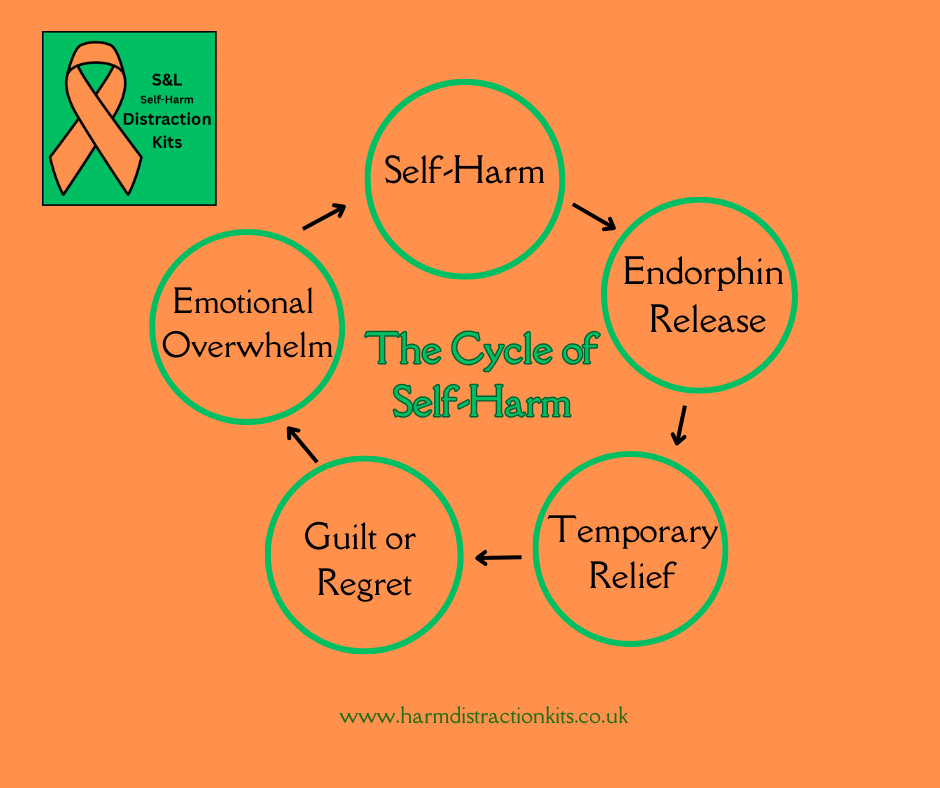Breaking the Cycle of Self-Harm:
- Sally Panks
- Jun 14
- 3 min read
Breaking the Cycle of Self-Harm: Understanding the Emotional Journey
Self-harm is a complex behaviour often misunderstood by those who have never experienced it. It’s not simply about inflicting pain; for many, it is a coping mechanism used to navigate overwhelming emotions and distress. Understanding the cycle of self-harm is vital in fostering empathy and support for those affected. This blog will explore how the cycle perpetuates itself, the temporary relief it provides, and the underlying issues of shame and guilt that often follow.
The Cycle of Self-Harm
1. Triggering Emotions:
The cycle typically begins with a trigger, which can be an overwhelming feeling such as sadness, anger, anxiety, or stress. For many individuals, these emotions can feel intense and unmanageable, leading them to seek a release.
2. Self-Harm as a Coping Mechanism:
In response to these overwhelming feelings, individuals may engage in self-harm as a way to cope. The physical pain becomes a temporary distraction from emotional turmoil. The act of self-injury can lead to the release of endorphins, chemicals in the brain that create feelings of pleasure and relaxation. This rush can provide momentary relief, helping to calm and relax the body during an emotional crisis.
3. Temporary Relief:
The endorphin release associated with self-harm is often short-lived. While individuals may feel a sense of calm and a reprieve from their emotional pain in the moment, the relief is fleeting. This physiological response can create a dangerous cycle where the individual begins to associate self-harm with a temporary escape from their distress.
4. Following the Act: Shame and Guilt:
Unfortunately, the momentary relief often gives way to feelings of shame and guilt. Once the temporary effects wear off, individuals may feel regret for resorting to self-harm. This negative emotional state is compounded by underlying issues, such as low self-esteem, feelings of inadequacy, or unresolved trauma. The cycle continues as they may once again seek to manage these distressing emotions through self-harm.
5. Reinforcement of the Cycle:
This cycle can become a repeating pattern: triggers lead to self-harm for temporary relief, followed by feelings of shame and guilt. Each iteration reinforces the behaviour, making it increasingly challenging for individuals to break free from the cycle. Over time, self-harm can become a habitual response to emotional distress, creating a dependency on this unhealthy coping mechanism.

Addressing the Cycle: Seeking Help
Recognising this cycle is the first step toward breaking it. Many individuals who self-harm struggle with underlying emotional issues that need to be addressed with the help of professionals. Counselling or therapy can provide a safe space to explore these feelings without judgment and develop healthier coping strategies.
Effective Coping Strategies
To replace the cycle of self-harm, it’s crucial to explore alternative coping mechanisms that address emotional distress without causing physical harm. Here are some healthier strategies to consider:
1. Mindfulness and Relaxation Techniques: Practicing mindfulness, deep breathing exercises, or yoga can help individuals manage anxiety and emotional pain more effectively.
2. Creative Expression: Engaging in creative activities such as drawing, painting, or writing can provide an outlet for emotions and promote healing.
3. Physical Activity: Regular exercise can trigger endorphin release naturally, improving overall mood and reducing feelings of stress and anxiety.
4. Support Networks: Encouraging connection with friends, family, or support groups can help combat feelings of isolation and provide emotional support during difficult times.
5. Professional Support: Seeking guidance from a counsell
or or therapist can help individuals work through their feelings and develop healthier methods of coping.
Conclusion
Understanding the cycle of self-harm is essential for fostering compassion and support for those affected. While self-harm may offer temporary relief through endorphin release, the subsequent feelings of shame and guilt can perpetuate a harmful cycle. By addressing the underlying emotional issues and implementing healthier coping strategies, individuals can begin to break free from this cycle and find more positive ways to navigate their feelings.
If you or someone you know is struggling with self-harm, reach out for support. Breaking the cycle is possible, and there is help available for those who seek it.




Comments